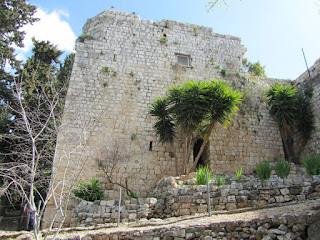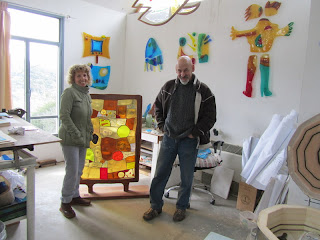(Article written to Reporter, the Jewish newspaper of New Hampshire. Photo by Roslyn Garber)
Winter in Netanya, Israel
Part One
Winter in Netanya didn’t begin in 2011 when we made our reservations with Hadassah. It actually began when we visited Israel in 2006, when we spent ten days there with the Manchester Jewish Federation’s mission trip. Linda and I realized we wanted to spend more than ten days in Israel. The challenge was how to accomplish this idea.
At first we thought we would rent an apartment possibly in the Hof HaCarmel region. Hof HaCarmel is our sister city region. We hosted Ziva Kainer, an artist who visited New Hampshire in 2009 for a Shabbat dinner. She told Linda that she was more than welcome to use her studio when we visited. Unfortunately, the Hof HaCarmel region suffered a tragic fire and many people lost their homes and art studios along with all of their artwork. Ziva was one of those individuals.
Serving as the treasurer of the Manchester Chapter of Hadassah for many years, Linda learned about Hadassah’s Winter in Netanya volunteer trip. We reviewed the offerings of either a four or an eight week trip and decided on going for eight weeks. We signed up in October of 2011.
The flights to Tel Aviv depart from Newark, New Jersey so you must arrange for additional transportation to Newark. Hadassah’s travel agency did that for us and saved us two hundred dollars. Our journey began on Tuesday, January 17, 2012. We will return on Monday, March 12th.
We are staying at the King Solomon hotel in Netanya for six weeks. Then we will spend a week in Eilat in the south and finally the last week in Jerusalem. Neither one of us had to cook for the entire trip which was a nice change. We had an enjoyable room with a balcony facing the Mediterranean Sea in Netanya.
The volunteering portion of our trip had us spending two mornings a week at a boy’s boarding school which has 80% Ethiopian immigrants. We worked with students on English communication skills during four sessions each visit. The second portion of our volunteering was to spend two mornings with the students at Tchernikovsky High School. Again we provided English communication skills for students who were fluent in Hebrew and in English. Everyone of our group benefited a great deal by working with each one of these schools. These are lifetime memories. Based on the relationships developed with some of these students we know they benefited as well.
We must tell you that we are only two of the six members who are first timers on this trip. Others have come back with the group many times. The group ranges in age from 59 to 89.
Every Tuesday we had a day trip visiting a site in Israel that continues to shed more light on the magnificence of this great country and its people. To date we have visited parts of Jerusalem we were never in before including the Burma Road which saved the security of the state in the war of Independence. We visited the city of Petach Tikvah which began in 1878 as an agricultural settlement and today is over 230,000 people. The final part of last Tuesday’s trip took us to Hadassah Neurim. It is a boarding and day school where Hadassah is a sponsoring partner. It felt good to see how our contributions to Hadassah were working. Tomorrow we are off to the Hula Valley to watch the bird migration that Gershon Peleg told us about last September.
Gershon took us to his kibbutz the first weekend we arrived and gave us the full tour of the fish processing operation and the lagoons which are netted to aid in keeping the migrating birds from eating the fish. He provided lunch for us at the community center and we met his wife Rina who joined us. Rina invited us back to their home for coffee, tea and cake before Gershon drove us back to Netanya.
If you would like to learn how to speak Hebrew there is a beginner’s level class and an advanced level class in the afternoons on the four days when we work in the schools. Fridays and Saturdays are our own time to do as we wish.
As we write this article, it is February 7th and we visited the Hula Valley in northern Israel. If you heard one of Gershon Peleg’s presentations last September you would have heard him mention the bird migrations in the Hula Valley. Our trip ended today with a visit to the area of the valley where the birds migrate twice a year once in spring time and again in the fall. We were hauled around in a long carriage with forty-eight seats pulled by a John Deere tractor. The carriage held our group and others. The driver drove us right into the swarms of birds congregated on the ground waiting while the feeder truck dropped food for them (corn). There were thirty-three thousand birds in front of us. Try and imagine looking at thirty-three thousand Euroasian Common Cranes with wing spans of 180-210 cms. They are over a meter in height when fully grown and weigh 7-8 kilograms. It was so amazing I had to call Gershon to thank him for his presentations as they made the day that much more meaningful.
We also need to mention that on the way north we visited an Ecological Farm called Emek HaShalom (Valley of Peace). This farm which grows olives and oranges is the only handicapped visiting center for all types of handicaps and is fully accessible to everyone. It was a heartwarming experience.





















